Inappropriate elimination, leading to litter box problems, is the most common behavioral concern for cat owners. As per ScienceDirect, many owners have cited litter box accidents as the reason for relinquishing their cats to shelters. This behavioral problem could be of different types – some use their litter box only to defecate but not urinate or vice versa, some miss the box due to non-alignment, some eliminate outside the box despite clean litter, while others stop using the box altogether.
ASPCA states that at least 10% of all cats develop elimination problems. While several factors could contribute to this behavior, the good news is that most factors that cause inappropriate elimination can be rectified to encourage the proper use of litter boxes. Thus, when litter box accidents happen, it is in the best interest of the cat owners to have patience, empathize with their beloved cats, understand the causes of their behavior, and make the litter box cat-friendly.
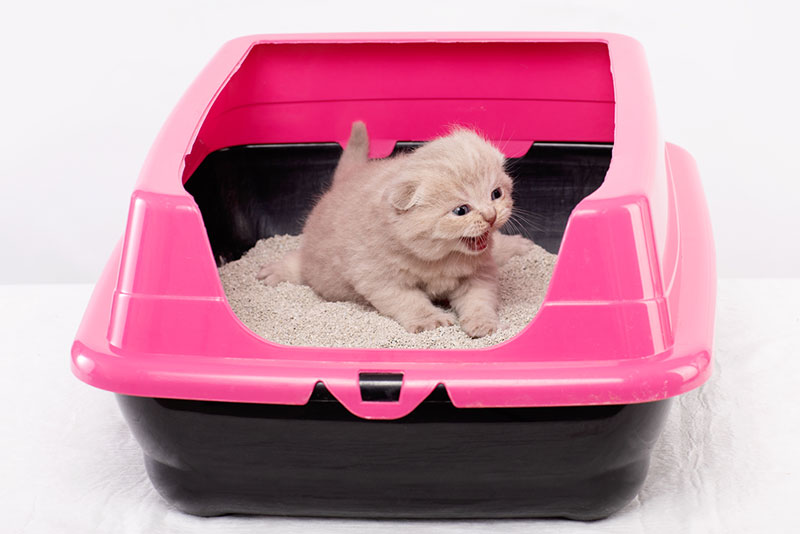
Cats refuse to use the litter box when they are not comfortable with it or cannot reach it easily. Some reasons are easily manageable, like ensuring a clean litter box and placing it in a proper location, while others need more attention and care, such as health conditions.
Here are some ways in which you can help alleviate causes of litter box problems:
Spaying can lessen spraying:
If your male cat is unneutered, he might have the impulse to mark his territory. In this case, urine marking happens to let female cats know of the male cat’s reproductive availability with a typical “tomcat” odor. The immediate action is to get your male cat neutered. Spaying will minimize the strong and pungent smell and motivate the cat to spray less. However, this behavior might not stop completely. International Cat Care states that approximately 10% of neutered males continue urine spraying and marking.
Like us, cats hate unclean bathrooms:
Cats are perfectionists about their hygiene. They love keeping themselves clean and well-groomed. It is natural for them to find messy litter boxes gross and not enter them. They prefer holding it rather than using an unclean box. This practice also indicates possible health issues in cats.
Furthermore, a messy litter box can also cause health problems in humans. To keep yourself and your cats safe, clean the litter boxes thrice a day (morning, late afternoon, and before going to bed) and change your cat’s litter at least once in two weeks. We recommend rinsing the litter box out thoroughly with unscented soap or baking soda at least once a month. Avoid scented cleaners as that might make it difficult for the cat to identify the litter box and be comfortable with it.
Make the litter box and litter suitable to your cat’s needs:
The actual consumer of the litter box is your cat. Unfortunately, while buying litter boxes, their needs are overlooked. Not all litter boxes are created equal for all cats. You will have to test a couple of options to ascertain the best litter box for your cat.
Litter box preference: Are open or closed litter boxes better?
A hood or liner on the box might make your cat uncomfortable. Maybe the box is too small for her. A large box makes it easy for her to enter and choose whichever spot she prefers. Studies do not show any preference towards the type of litter boxes – open or closed. Cats are fine with either, provided the box is clean. An open litter tray works very well as it is lightweight, easy to clean, and has a rim that efficiently prevents the litter from being thrown out of the box. We recommend Savic Iriz Cat Litter Tray with Rim. It is made of high quality and claims to reduce odor. We have used this budget litter box for our kittens, and it has worked quite well.
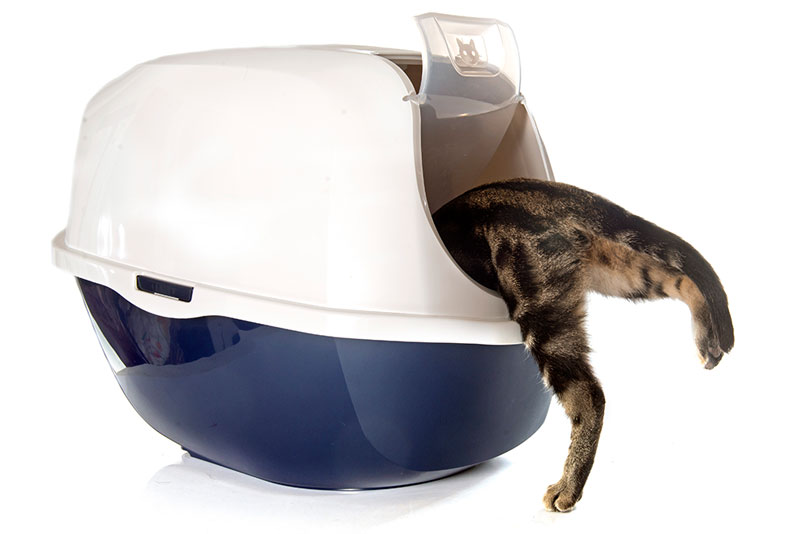
A closed litter box is helpful for you if your cat digs excessively and litter gets thrown out. It also helps control odor and blends better with home decor. If you want to purchase an enclosed box, Trixie Vico Cat Litter Tray with Dome is a good option. It comes with a double and extra high rim to prevent urine and litter from being scattered out of the tray. However, it would help if you also considered that enclosed litter boxes might not be the best option for your felines as they prefer an open box to see probable threats and escape them. Also, in a closed litter box, the chances of improper cleaning are more. Over a while, if the foul smell lingers in the closed box, your cat will reduce the visits.
Another option for people who do not have much time to scoop is a self-cleaning litter box. It self-cleans for weeks with no scooping, cleaning, or refilling required. The odor control feature helps the cat to use it without any smell problem. If money is not a concern and you prefer a self-cleaning litter box, we recommend PetSafe ScoopFree Self-Cleaning Cat Litter Box Tray Refills with Premium Blue Non-Clumping Crystals – 3 Pack. It offers unbeatable odor control, lessens the chances of mess, provides leak protection, and is easy and convenient to clean. Despite being self-cleaning, you will have to clean it periodically as odor builds up in them.
There are more complex electronic options available in the market that can help you with your busy schedule, but you need to know that more complicated devices have more chances of failing. It can invite unclogged and unclean areas in the litter box, discouraging the cat from using it over time.
Litter Preference: What type of litter do cats prefer?
Usually, cats prefer unscented, clumping litter with medium to fine texture. Cats have strong senses for smell and touch that help them hunt at night. Having such sensitivities can impact their association with litter. If the cat is accustomed to a particular type of litter, changing it suddenly might make them refuse to use it. Also, stray cats are habitual to use soil for elimination purposes. It is too much to expect a stray cat to suddenly shift to a litter of your choice, as they do not associate with it.
If the litter in your cat’s box is too deep, you might see them enter the box and then jump out quickly. Extra litter won’t reduce the amount of cleaning required. So, refrain from filling up a lot, but make sure it is enough for the cats to eliminate and cover it. Cats prefer one to two inches deep litter.
Bottom line: To make your cat like the litter box, give her options and a chance to choose. The only other way she can tell you that she doesn’t like it is by eliminating outside. You can place a couple of large litter boxes side by side and try out different types of litter. An unscented, clumping litter with medium to fine texture works best for cats.
We have listed our recommended Litter, Waste, and Cleanup Essentials right here.
Make the litter box’s location and surrounding cat-friendly: Where should I place the litter box?
Some cat owners prefer hiding the litter box in some cabinets or closets to keep the foul smell in the box. If the place where you have placed the litter box is primarily inaccessible, your cats are bound to develop a behavior problem. It is also possible that your cat does not prefer the litter box’s location because it is too remote or too crowded. You can pick a quiet place that is free of disturbance and obstacles, but also someplace from where your cat can see you. That is genuinely comforting for cats. If you live in a multistorey apartment, place a litter box on every level. You do not want your cat to keep rushing for the litter box when in need.
How many litter boxes should I have?
The golden rule is to have one litter box per cat plus one. So, for one cat, have two boxes, for two cats have three boxes, for three cats have four boxes, and so on.
In a multi-cat household, sometimes it so happens that one cat dominates access to litter boxes. She could be the oldest or the newest one. The dominating cat will prevent other cats from entering the box. This can also happen when a conflict is developing between cats. Cats perceive litter boxes as way more than a bathroom. It is their sacred spot with which they associate good memories and welcome other cats they love. If you have few boxes for many cats, it might lead to aversions and negative association if the cats are not fond of one another. This will gradually force them to mark territory despite being spayed or eliminate anywhere but not in the box. So, ensure to provide all your cats with their scared spots and add one more to be on the safe side.
Make your cat build a positive association with the litter box:
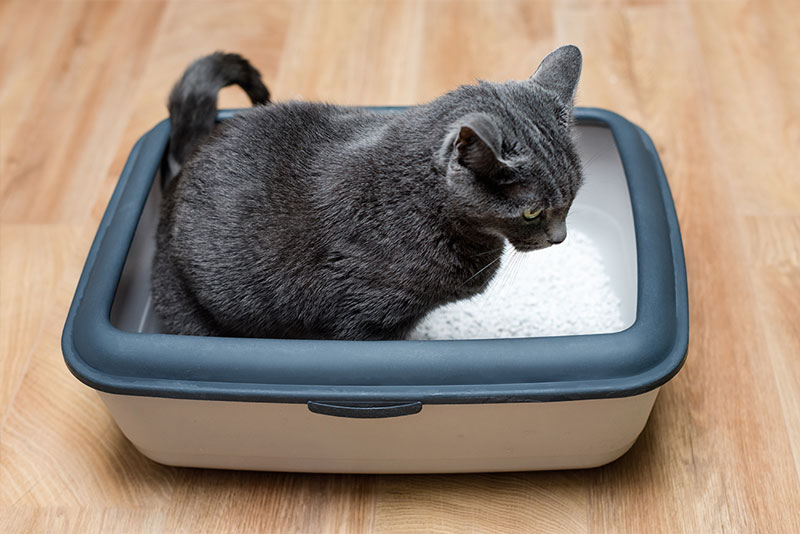
If you notice that your cat enters a litter box and jumps out too quickly, she might have experienced something negative while being in the box earlier. It could be any unpleasant experience such as being cornered or attacked by another creature, startled due to disturbingly loud noise, a scary sight, etc. If you feel that your cat is explicitly showing dislike towards a litter box, try associating it with positive feelings. It is tough to build such positive associations all by yourself because you cannot force your cat to believe that the box is safe as she might think against it. We recommend professional help from certified animal behaviorists who can help with a counterconditioning program.
Before getting professional help, you can make some harmless changes in the environment to explore possibilities:
- Change the location of your cat’s litter box
- Change the litter if you think that litter is something that the cat is avoiding
- Spend more time with your cat and show your affection for her near the litter box
- Play with her near the litter box
- Eliminate sources of stress. You can identify these only through observation
Your cat with limitations or special needs deserves extra love and care:
It is highly essential to consider the physical limits of your cats – obese, older, arthritic, very young cats or cats with other physical problems will find it uncomfortable to use litter boxes with high sides or top-entry boxes. They might also feel restricted in enclosed boxes, especially those that expect your cat to push through the plastic flaps to enter the cramped boxes. Provide an open-spaced large-sized litter box in which your cat with any physical ailment can enter and exit quickly.
Observe litter box problems as they may indicate a medical concern:
Contact a veterinarian immediately if you notice litter box problems along with inconsistency in the feces/urine. Your vet might ask for stool/urine samples to diagnose the underlying problem if any. We urge you to observe the elimination patterns and keep a tab on the consistency of the motions. Cats are brilliant at hiding their pain, so litter box problems in such cases could happen because your cat is depressed with the internal upheaval and does not know what to do about it.
The medical condition could be anything from a Urinary Tract Infection (UTI) to Feline Interstitial Cystitis to Kidney Stones or blockages or a more severe condition. It could be UTI if your cat enters the box can pass minimal amounts of urine. It could be a Feline Interstitial Cystitis if your cat attempts to urinate frequently but often ends up straining with a small amount of urine passed. This is a life-threatening neurological disease that inflames a cat’s bladder and causes much pain while urinating. Cats with kidney stones or blockage cry a lot due to pain. Passing urine or feces, in this case, is also quite tricky. Your cat might also be suffering from diarrhea or gastrointestinal problems. Some causes include parasites, infections, diet changes, stress, primary inflammatory disorders, metabolic diseases, mediations/toxins, constipation.
We also listed down 6 of the most dangerous diseases in cats here.
All the other possibilities of litter box problems given above are manageable over time if you make some changes to your environment to suit your cat’s needs. Eventually, your cat might start using the litter box as excepted. However, an underlying health condition needs immediate medical attention. Do not waste any time and contact a veterinarian right away if you feel that your cat’s litter box accidents result from a health issue. Once medical problems are ruled out, work towards understanding the reason for your cat’s inappropriate elimination behavior and patiently work towards improving it.
As a final note, we want to share a checklist to prevent litter box problems with your cat
Rule out medical problems with the help of your veterinarian. | |
Rule out urine marking, get your cat neutered. | |
Check for signs and sources of stress. | |
Empathize with your cat. Do not punish for these accidents. | |
Provide enough litter boxes. | |
Golden rule: 1 litter box per cat + 1 | |
Place litter boxes in accessible locations | |
Remove covers from litter boxes. | |
Let your cat choose from different types of litter. | |
Scoop thrice a day. | |
Rinse the litter box thoroughly once a month with baking soda. | |
Clean accident sites thoroughly. | |
Observe where your cat eliminates and place the litter box there. | |
Discourage from eliminating in improper areas/ surfaces by making them less pleasing. | |
Switch to litter boxes with low sides for cats with special needs | |
Give your cat a safe and secure space right from the start to avoid any possibility of your negative association with the litter box. | |
In a multi-cat household, let your scared/anxious cat choose her spot of elimination and place the box there. | |
Never drag your cat to a litter box or force her into it. | |
Never confine your cat with a litter box in a room. | |
Avoid ammonia-based cleaners to clean the accidents. |



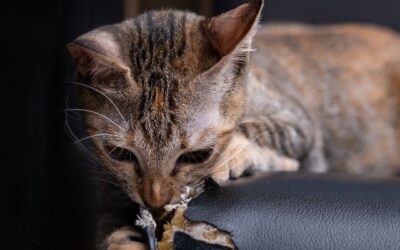
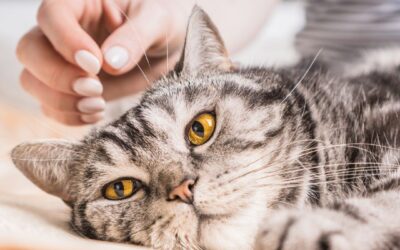
0 Comments
Trackbacks/Pingbacks